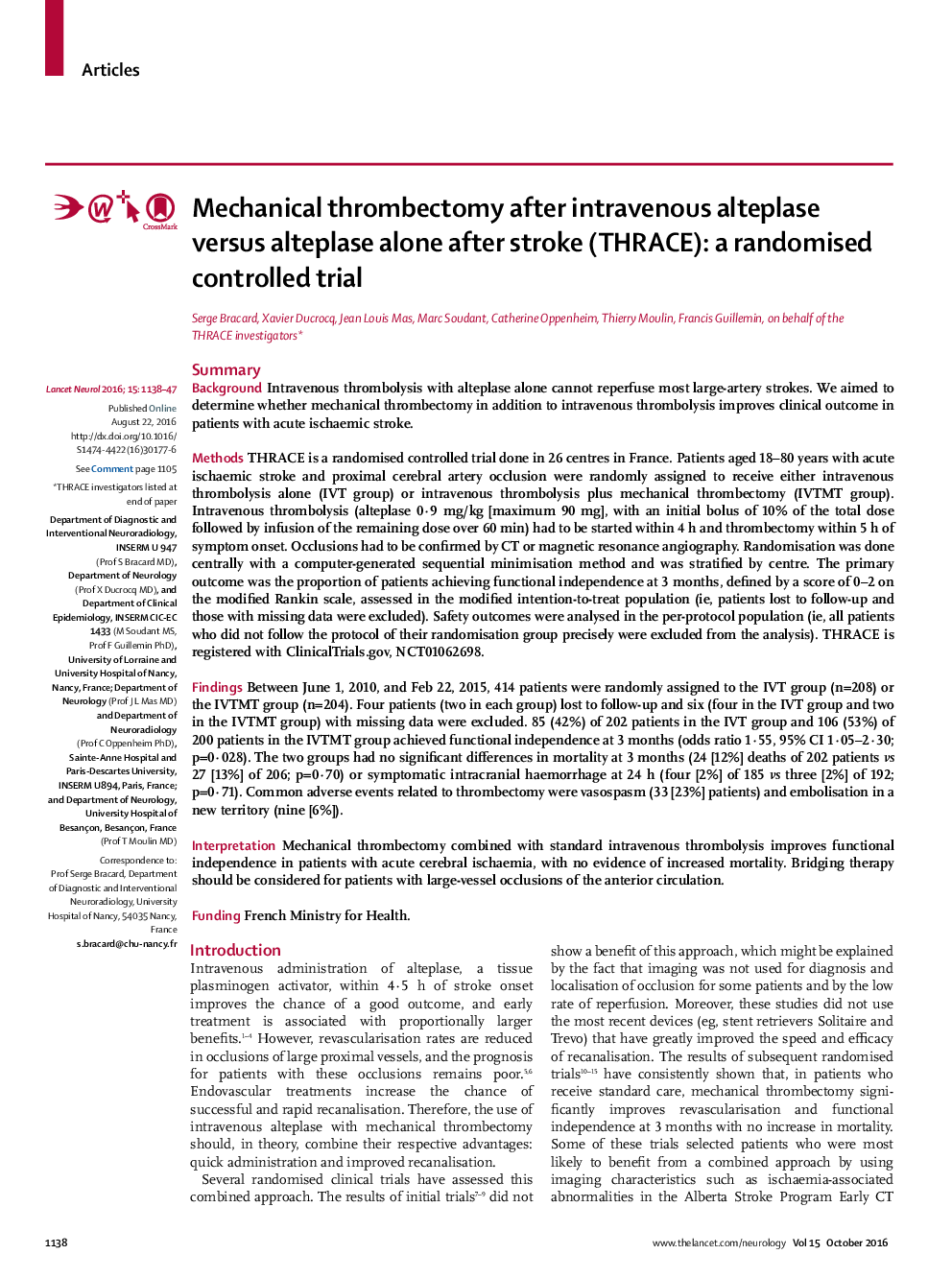| کد مقاله | کد نشریه | سال انتشار | مقاله انگلیسی | نسخه تمام متن |
|---|---|---|---|---|
| 3066182 | 1406459 | 2016 | 10 صفحه PDF | دانلود رایگان |

SummaryBackgroundIntravenous thrombolysis with alteplase alone cannot reperfuse most large-artery strokes. We aimed to determine whether mechanical thrombectomy in addition to intravenous thrombolysis improves clinical outcome in patients with acute ischaemic stroke.MethodsTHRACE is a randomised controlled trial done in 26 centres in France. Patients aged 18–80 years with acute ischaemic stroke and proximal cerebral artery occlusion were randomly assigned to receive either intravenous thrombolysis alone (IVT group) or intravenous thrombolysis plus mechanical thrombectomy (IVTMT group). Intravenous thrombolysis (alteplase 0·9 mg/kg [maximum 90 mg], with an initial bolus of 10% of the total dose followed by infusion of the remaining dose over 60 min) had to be started within 4 h and thrombectomy within 5 h of symptom onset. Occlusions had to be confirmed by CT or magnetic resonance angiography. Randomisation was done centrally with a computer-generated sequential minimisation method and was stratified by centre. The primary outcome was the proportion of patients achieving functional independence at 3 months, defined by a score of 0–2 on the modified Rankin scale, assessed in the modified intention-to-treat population (ie, patients lost to follow-up and those with missing data were excluded). Safety outcomes were analysed in the per-protocol population (ie, all patients who did not follow the protocol of their randomisation group precisely were excluded from the analysis). THRACE is registered with ClinicalTrials.gov, NCT01062698.FindingsBetween June 1, 2010, and Feb 22, 2015, 414 patients were randomly assigned to the IVT group (n=208) or the IVTMT group (n=204). Four patients (two in each group) lost to follow-up and six (four in the IVT group and two in the IVTMT group) with missing data were excluded. 85 (42%) of 202 patients in the IVT group and 106 (53%) of 200 patients in the IVTMT group achieved functional independence at 3 months (odds ratio 1·55, 95% CI 1·05–2·30; p=0·028). The two groups had no significant differences in mortality at 3 months (24 [12%] deaths of 202 patients vs 27 [13%] of 206; p=0·70) or symptomatic intracranial haemorrhage at 24 h (four [2%] of 185 vs three [2%] of 192; p=0·71). Common adverse events related to thrombectomy were vasospasm (33 [23%] patients) and embolisation in a new territory (nine [6%]).InterpretationMechanical thrombectomy combined with standard intravenous thrombolysis improves functional independence in patients with acute cerebral ischaemia, with no evidence of increased mortality. Bridging therapy should be considered for patients with large-vessel occlusions of the anterior circulation.FundingFrench Ministry for Health.
Journal: - Volume 15, Issue 11, October 2016, Pages 1138–1147